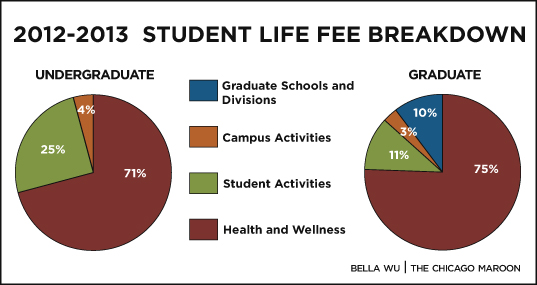University administrators fielded student questions about the Student Life Fee with the intention of providing more transparency regarding its allocation at a Student Government Assembly meeting Thursday night. They also announced the eventual creation of a Web site to publicly inform students of the breakdown of Student Life Fee allocation and addressed student complaints about the Student Health Service (SHS), which is funded by the Student Life Fee.
Assistant Vice President for Student Life and Associate Dean of the College Eleanor Daugherty explained that the impetus for the meeting emerged from initial conversations last year with former SG president Youssef Kalad (A.B. ’12), who had expressed concern over a lack of transparency and inquired whether students could have more input in the allocation of the fee.
This year, the Student Life Fee for students in the College is $331 per quarter for fall, winter, and spring, while the fee for graduate students is $310 per quarter.
Daugherty’s presentation broke down the Student Life Fee into three major categories: Health and Wellness, which includes the Student Health and Counseling Services and the Health Promotion and Wellness Team; Student Activities, which includes RSO funding, Student Government, and campus programming; and Campus Activities, which includes 24/7 campus resources like the Dean-On-Call, Sexual Assault Dean-On-Call, and the Bias Response Team.
For undergraduates, 71 percent of the fee is apportioned to Health and Wellness, 25 percent to Student Activities, and 4 percent to Campus Activities. For graduates, 75 percent goes to Health and Wellness, 11 percent to Student Activities, 3 percent to Campus Activities, and 10 percent is given back to the individual graduate schools and divisions.
ORCSA interim director Jen Kennedy stressed the importance of the Central Fund for Student Activities, which is administered by ORCSA, as a vast majority of the fund directly benefits student organizations.
For the 2012-13 academic year, 82 percent of the Central Fund goes directly to student organizations, 6 percent goes to “student organization training and support,” which includes the services provided by the Student Activities Center in the Reynolds Club, 10 percent goes to campus-wide programming and initiatives, such as the New York Times Collegiate Readership Program, and 2 percent goes to SG.
In addition, Kennedy noted that student-run funding bodies, such as the Annual Allocations Committee, the SG Finance Committee, and the Uncommon Fund, are responsible for administering 90 percent of the money contained in the Central Fund.
In the Q & A following the presentation, SG representatives voiced concerns about the availability of care at the SHS.
First-year College Council Rep Timi Koyejo asked whether the SHS would consider opening up the clinic for walk-ins or expanded hours to better serve students needing prompt care.
Assistant Vice President for Student Health and Counseling Services Alex Lickerman said that allowing walk-ins would disrupt the regular appointments. However, he announced that a Saturday clinic is in the works and would likely be implemented later this academic year.
Daugherty hopes students will contribute more to addressing areas which may require more funding.
“One of the things that I like a lot is that it’s enormously student-informed. I don’t want to just sit in a room with ORCSA and say, ‘Look, this would be fun.’ I see an opportunity to directly ask student leaders what we should be working on. I appreciate student input because you know it. You are it. ‘I serve it.’”









